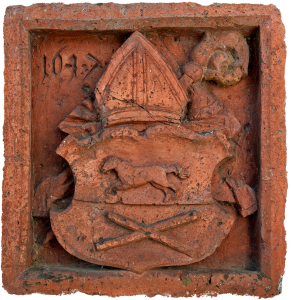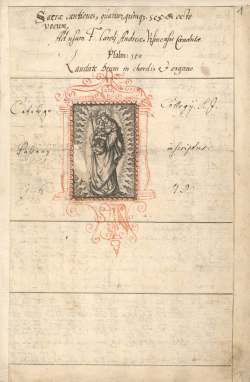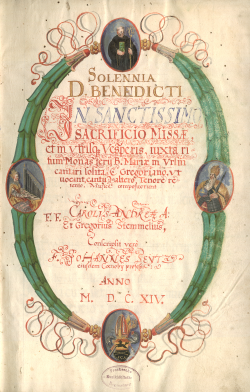 Musical life at Irsee Monastery underwent a period of intense activity during the rule of Abbot Carolus Andreae (Karl Enders or Endres), who served from 1612–1627. Additional information concerning his career path has vanished in subsequent periods of unrest. However, we know from his works that he was an exceptionally gifted composer. He also collected music manuscripts that may well have formed the basis of the musical life of the monastery. It is highly likely that he initiated the building of the new organ by the Irsee organ builder Daniel Hayl for the abbey church in 1612.
Musical life at Irsee Monastery underwent a period of intense activity during the rule of Abbot Carolus Andreae (Karl Enders or Endres), who served from 1612–1627. Additional information concerning his career path has vanished in subsequent periods of unrest. However, we know from his works that he was an exceptionally gifted composer. He also collected music manuscripts that may well have formed the basis of the musical life of the monastery. It is highly likely that he initiated the building of the new organ by the Irsee organ builder Daniel Hayl for the abbey church in 1612.
 An organ tablature from 1590 that is [currently] preserved in the Passau State Library must have arrived at the Passau Jesuit College in 1679. The first two headings state that the manuscript was created for the use of Brother Carolus Andreae, a monk at Irsee. It is written in German organ tablature, which uses letters to indicate the pitches. There is some doubt as to whether the tablature was written for (the use of) Brother Carolus or he wrote it himself.
An organ tablature from 1590 that is [currently] preserved in the Passau State Library must have arrived at the Passau Jesuit College in 1679. The first two headings state that the manuscript was created for the use of Brother Carolus Andreae, a monk at Irsee. It is written in German organ tablature, which uses letters to indicate the pitches. There is some doubt as to whether the tablature was written for (the use of) Brother Carolus or he wrote it himself.
His confrere, Father Gregor Stemmele came to Irsee from Peissenberg in the late 1570’s. A prolific composer, he shaped the musical life of the monastery until his death in 1619. His surviving works include: a mass on Missa super „Si ignoras te“ with a Proper and chants for both parts of Vespers, sixty-four fauxbourdon, various Magnificat antiphons and compositions for the Proper, an Ave maris stella, several communion motets, Sunt hodie fratres (a motet on the subject of John the Baptist), Si enim credimus for the Office of the Dead, and a psalm for Vespers, In exitu Israel.
 Two choirbooks bearing the shelfmarks Tonkunst Schletterer 95 and 96 are preserved in the Augsburg City and State Library. Four additional choirbooks from Irsee, among them a single codex titled Solennia, must have come onto the fine art market at an earlier point. Carl Proske (1794–1861) acquired them from the Augsburg antiquarian bookseller Butsch and subsequently placed them in his personal library. From there, they arrived at the Main Diocesan Library in Regensburg. Since the nineteenth century, these magnificent volumes in the library’s Proske Collection have borne the shelfmarks C90 to C93.
Two choirbooks bearing the shelfmarks Tonkunst Schletterer 95 and 96 are preserved in the Augsburg City and State Library. Four additional choirbooks from Irsee, among them a single codex titled Solennia, must have come onto the fine art market at an earlier point. Carl Proske (1794–1861) acquired them from the Augsburg antiquarian bookseller Butsch and subsequently placed them in his personal library. From there, they arrived at the Main Diocesan Library in Regensburg. Since the nineteenth century, these magnificent volumes in the library’s Proske Collection have borne the shelfmarks C90 to C93.
Johannes Seytz († 1619), a Benedictine monk from Irsee Monastery, penned all six choirbooks. The table of contents in each of these sources is rather cosmopolitan: The names of various Italian masters and composers from Protestant Central and North Germany appear alongside those of the Irsee composers Carolus Andreae and Gregorius Stemmele. Irsee may have been situated in the provinces but, due to an extensive network of connections to the wider world, the people certainly don’t seem to have been provincial. The Irsee monastic register of 1593 lists a total of thirteen members, which must have included a small number of choir boys. At the time of Abbot Carolus, membership in the community was almost the same as in 1593. Considering the high quality of compositions and the opportunities to perform them at the monastery, one cannot help but feel great admiration for Irsee.




